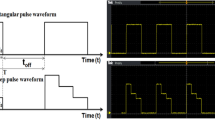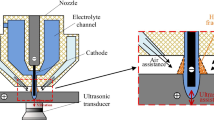Abstract
Microdimples as a typical surface texture has been widely used for improving the properties in tribology and heat transfer fields. Ultrasonically assisted electrochemical micromachining (USEMM) is a popular method for generating microdimples as it can reduce the overcutting and enhance electrolyte renewal to improve the machining localization and promote the material removal. However, the fundamental understanding of the process and particularly the relationship between the machining performance and gap pressure is limited. In this paper, radial ultrasonicrolling electrochemical micromachining (RUREMM) is employed to generate microdimples on SS304 surface. Effects of gap pressure on the material removal rate, machining accuracy, and roughness are studied and discussed in detail. Results show that RUREMM can fabricate the microdimples and the existing ultrasonic vibration in the inter-electrode gap is more effective to enhance the machining performance. By using the selected parameters in RUREMM, the current density during machining has a 6.6% increase in RUREMM than in EMM. Moreover, the width of the microdimple is decreased by 14.6%, the depth of the microdimple is increased by 19.2%, the cross-sectional area of the machined dimple is expanded by 31.2%, the roughness of the bottom is decreased 23.9% and also, better surface quality for the side wall could be obtained.
















Similar content being viewed by others
References
Gandhi R, Sebastian D, Basu S, Mann JB, Iglesias P, Saldana C (2016) Surfaces by vibration/modulation-assisted texturing for tribological applications. Int J Adv Manuf Technol 85:909–920
Patel DS, Jain VK, Shrivastava A, Ramkumar J (2019) Electrochemical micro texturing on flat and curved surfaces: simulation and experiments. Int J Adv Manuf Technol 100:1269–1286
Xiao N, Khonsari MM (2012) Thermal performance of mechanical seals with textured side-wall. Tribol Int 45:1–7
Colombo D, Previtali B (2014) Laser dimpling and remote welding of zinc-coated steels for automotive applications. Int J Adv Manuf Technol 72(5–8):653–663
Chan HJ, Kim BH, Bo HK, Chong NC (2009) Micro electrochemical machining for complex internal micro features. CIRP Ann Manuf Technol 58(1):181–184
Wang MH, Peng W, Yao CY, Zhang QF (2010) Electrochemical machining of the spiral internal turbulator. Int J Adv Manuf Technol 49(9):969–973
Li HS, Wang GQ, Zheng X, Zeng YB (2014) Distribution mannerof compaction circular cylinders in through-active-mask electrochemical machining. Adv Mech Eng 7(2): 187–193
Wang XS, Giovannini M, Xing YQ, Kang M, Ehmann K (2015) Fabrication and tribological behaviors of corner-cube-like dimple arrays produced by laser surface texturing on medical needles. Tribol Int 92:553–558
Liew KW, Kok CK, Efzan MNE (2016) Effect of EDM dimple geometry on friction reduction under boundaryand mixed lubrication. Tribol Int 101:1–9
Ahuir-Torres JI, Arenas MA, Perrie W, Dearden G, Damborenea JD (2017) Surface texturing of aluminium alloy AA2024-T3 by picosecond laser: effect on wettability and corrosion properties. Surf Coat Technol 321:279–291
Wang YF, Zeng YB, Zhang WW (2019) Improving the machining efficiency of electrochemical micromachining with oscillating workpiece. Int J Adv Manuf Technol 102:2695–2708
Debnath S, Doloi B, Bhattacharyya B (2019) Review—wire electrochemical machining process: overview and recent advances. J Electrochem Soc 166(10):293–309
Xu K, Zeng YB, Li P, Fang XL, Zhu D (2016) Experimental research on multiple wire electrode electrochemical micro machining. Int J Electrochem Sci 11:5403–5415
Byun JW, Shin HS, Kwon MH, Kim BH (2010) Surface texturing by micro ECM for friction reduction. Int J Precis Eng Manuf 11:747–753
Hackert-Oschätzchen M, Meichsner G, Zinecker M, Martin A, Schubert A (2012) Micro machining with continuous electrolytic free jet. Precis Eng 36:612–619
Hackert-Oschätzchen M, Paul R, Martin A, Meichsner G, Lehnert N, Schubert A (2015) Study on the dynamic generation of the jet shape in Jet Electrochemical Machining. J Mater Process Tech 223:240–251
Wang L, Wang Q, Hao XQ, Ding YC, Lu BH (2010) Finite element simulation and experimental study on the through-mask electrochemical micromachining (EMM) process. Int J Adv Manuf Technol 51:155–162
Chen XL, Qu NS, Li HS, Xu ZY (2016) Electrochemical micromachining of micro-dimple arrays using a polydimethylsiloxane (PDMS) mask. J Mater Process Tech 229:102–110
Qu NS, Chen XL, Li HS, Zhu D (2014) Fabrication of PDMS micro through-holes for electrochemical micromachining. Int J Adv Manuf Technol 72:487–494
Wang MH, Zhang YB, He ZW, Peng W (2016) Deep micro-hole fabrication in EMM on stainless steel using disk micro-tool assisted by ultrasonic vibration. J Mater Process Tech 229:475–483
Ruszaj A, Zybura M, Zurek R, Skrabalak G (2003) Some aspects of the electrochemical machining process supported by electrode ultrasonic vibrations optimization. P I Mech Eng B - J Eng Manuf 217(10):1365–1371
Natsu W, Nakayama H, Yu Z (2012) Improvement of ECM characteristics by applying ultrasonic vibration. Int J Precis Eng Manuf 13:1131–1136
Yang I, Park MS, Chu CN (2009) Micro ECM with ultrasonic vibrations using a semi-cylindrical tool. Int J Precis Eng Manuf 10:5–10
Vogel A, Busch S, Parlitz U (1996) Shock wave emission and cavitation bubble generation by picosecond and nanosecond optical breakdown in water. J Acoust Soc Am 100:148–165
Brujan EA, Ikeda T, Matsumoto Y (2008) On the pressure of cavitation bubbles. Exp Thermal Fluid Sci 32:1188–1191
Brunton JH (1966) High speed liquid impact. Philos T R Soc A 260:79–85
Funding
This work received financial support of the projects from the National Natural Science Foundation of China [grant numbers 51975532, 51475428] and the Zhejiang Provincial Natural Science Foundation [grant numbers LY19E050007].
Author information
Authors and Affiliations
Corresponding author
Additional information
Publisher’s note
Springer Nature remains neutral with regard to jurisdictional claims in published maps and institutional affiliations.
Rights and permissions
About this article
Cite this article
Wang, M., Chen, X., Tong, W. et al. Influences of gap pressure on machining performance in radial ultrasonic rolling electrochemical micromachining. Int J Adv Manuf Technol 107, 157–166 (2020). https://doi.org/10.1007/s00170-020-05012-7
Received:
Accepted:
Published:
Issue Date:
DOI: https://doi.org/10.1007/s00170-020-05012-7




